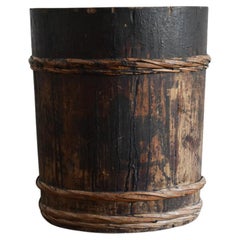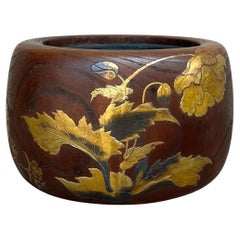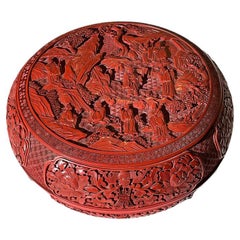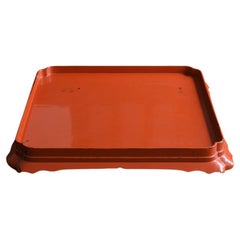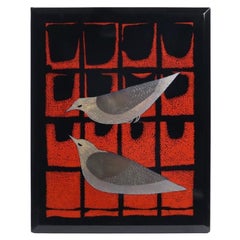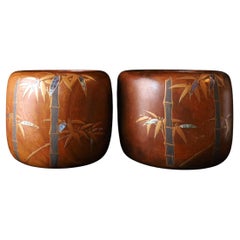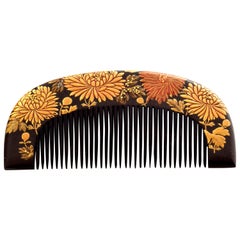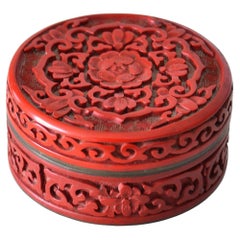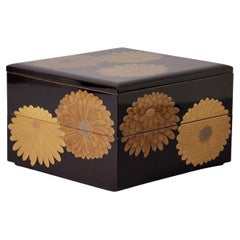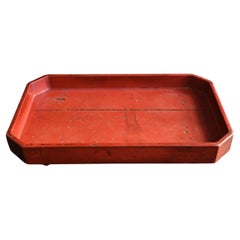Japan - Lacquer
to
383
151
26
2
12
12
2
1
20
18
4
2
2
23
23
22
1
26
26
26
Item Ships From: Japan
Antique wooden bucket of Japanese lacquer craftsman/20th century/planter
Located in Sammu-shi, Chiba
This is a wooden bucket used by Japanese lacquerware craftsmen to store lacquer.
It is believed to have been used from the Meiji period to the first half of the Showa era (1868-1940)...
Category
Late 19th Century Japanese Meiji Antique Japan - Lacquer
Materials
Cedar, Lacquer
Exceptional Japanese Lacquered Hibachi with Poppy Flowers in Gold and Silver Mak
Located in Fukuoka, JP
This magnificent hibachi (charcoal brazier), likely custom-made to order, exemplifies the pinnacle of Japanese lacquer artistry of the 19th century. Carved from solid wood with a ric...
Category
19th Century Japanese Edo Antique Japan - Lacquer
Materials
Copper
Chinese Antique Cinnabar Lacquer Round Box with Eight Hermit Design, Qing Period
Located in Chuo-ku, Tokyo
This extraordinary Chinese cinnabar lacquer round box is very detailed in amazing quality.
A technique of engraving pattern on thick layer of red...
Category
18th Century Chinese Qing Antique Japan - Lacquer
Materials
Wood, Lacquer
A large square tray made of Japanese antique lacquer / Late Edo period/19th
Located in Sammu-shi, Chiba
These trays were made after the late Edo period in Japan (after 1800).
This particular type of tray is known as "Negoro-bon."
Negoro lacquerware is a specific style of Japanese lacqu...
Category
19th Century Japanese Edo Antique Japan - Lacquer
Materials
Lacquer
Black Lacquer Box with Silver Birds by Hiroshi Mimura (1921–1975), Japan, Showa
Located in Fukuoka, JP
A striking and rare black lacquer box by celebrated Japanese lacquer artist Hiroshi Mimura (1921–1975), known for his bold, modernist reinterpretations of traditional techniques. Thi...
Category
20th Century Japanese Showa Japan - Lacquer
Materials
Silver Leaf
Pair of Japanese Hibachi with Inlaid Bamboo Motif
Located in Fukuoka, JP
A beautifully matched pair of Japanese hibachi (traditional fire bowls) from the Meiji period (1868–1912), showcasing exceptional craftsmanship and refined aesthetics. Each vessel is...
Category
Early 20th Century Japanese Taisho Japan - Lacquer
Materials
Wood
Set of 3 hibachi Incense burner Planters
Located in Fukuoka, JP
A rare and elegant set of three Japanese hibachi (traditional fire bowls) from the Meiji period (1868–1912), made of richly grained paulownia wood and intricately decorated with carv...
Category
20th Century Japanese Japan - Lacquer
Materials
Belgian Black Marble, Copper
$2,890 / set
Beautiful Japanese Lacquered Tray Raden Abalone Shell Decoration
Located in Fukuoka, JP
Beautiful Japanese Lacquered Tray with Raden Abalone Shell Decoration
This beautiful Japanese lacquered tray is a stunning example of Japanese craftsmanship. It is made of high-quality wood and is decorated with abalone shell inlay, a technique known as raden. Raden is a centuries-old Japanese art form that involves inlaying mother-of-pearl, abalone shell, or other materials into a lacquer surface. The technique originated in China and was introduced to Japan in the Nara period...
Category
20th Century Japanese Japan - Lacquer
Materials
Lacquer
Old Round Plate with Japanese Lacquer / Meiji-Taisho / Urushi
Located in Sammu-shi, Chiba
A wooden vessel used from the Meiji era to the Taisho era.
Probably a beech tree.
It is made by hollowing out.
It's very cool, isn't it?
It is a lacquered tall foot round tray made ...
Category
Mid-20th Century Japanese Taisho Japan - Lacquer
Materials
Beech, Lacquer
Uniquely Shaped Lacquer Box with Tachibana Clan Crests – 19th Century
Located in Fukuoka, JP
An impressive and unusually shaped Japanese lacquered box, bearing the gold crests of the prestigious Tachibana samurai clan. This elegant piece dates to the late Edo to early Meiji ...
Category
19th Century Japanese Edo Antique Japan - Lacquer
Materials
Wood, Lacquer
Japanese Antiques Nakajima Kaho, lacquer painting, cat, Folding fan-shaped frame
Located in Niiza, JP
Material: lacquer paint on paper
A cute lacquer painting of a cat.
A painter of the Maruyama(円山) school,
he is said to have learned calligraphy
from Tomioka Tessai(富岡鉄斎)
It is l...
Category
20th Century Japan - Lacquer
Materials
Paper
Japanese Antiques Mitamura Jiho Ivy Makie(Lacquer) Paper Box for calligraphy
Located in Niiza, JP
Mitamura Jiho 三田村自芳 Ivy Makie Lacquer Paper Box
290(W)× 130(H) × 365(D) [mm]
He have studied makie under Akatsuka Jitoku, the 8th master of the Edo makie Akatsuka school
He is an un...
Category
20th Century Japanese Japan - Lacquer
Materials
Wood, Lacquer
Japanese Negoro Style Lacquered Worship Stand, 17th-18th Century
Located in Fukuoka, JP
"Discover a piece of Japanese religious heritage with this exceptional Negoro lacquered stand. Crafted in the 17th to 18th century, this worship article stand is a prime example of e...
Category
Late 17th Century Japanese Edo Antique Japan - Lacquer
Materials
Wood, Lacquer
Edo Period Makie Lacquer Incense Burner with Bronze Receptor
Located in Fukuoka, JP
A Fine Lacquer Incense Burner with Makie Gold Design.
This fine lacquer incense burner is a stunning example of Japanese craftsmanship. It is dated to the Edo-Meiji period, 19th cen...
Category
19th Century Japanese Edo Antique Japan - Lacquer
Materials
Bronze
Japanese Antiques A paulownia lacquer Makie brazier with a deer and a lantern
Located in Niiza, JP
φ310× 205(H) [mm]
Box size: φ340×240㎜ 4㎏
Lovely design
A Kasuga lantern with a cute male and female deer in raised lacquer.
The grey parts are made with lead.
The window of the lant...
Category
19th Century Japanese Antique Japan - Lacquer
Materials
Wood
Japanese Antiques Lacquer craftsman's workbench, Abstract Painting
Located in Niiza, JP
Material: mainly Cedar board
A workbench used by lacquer craftsman.
Through years of use, natural layers of lacquer have formed, giving it a beautiful appearance like an abstract pa...
Category
19th Century Antique Japan - Lacquer
Materials
Wood
1937 Japanese Fish Sea Bream Carved Design Wooden Tray
Located in Fukuoka, JP
A Beautiful Japanese Wood Carving Tray with Carp Design.
This beautiful Japanese wood carving tray is a stunning example of Japanese craftsmanship. It is dated 1937 and is in good o...
Category
20th Century Japanese Taisho Japan - Lacquer
Materials
Wood, Lacquer
Japanese Antiques Inkstone box with Kasuga Deer Mandala Maki-e by Kan-sai
Located in Niiza, JP
245(W)× 50(H) × 250(D) [mm]
Box size: 280(W)× 100(H) × 300(D) [mm] 1.6kg
A beautiful composition of a mother and child deer is expressed in Taka-maki-e (raised maki-e technique)
Op...
Category
19th Century Japanese Antique Japan - Lacquer
Materials
Lacquer
Japanese Antiques Kokukokai Senzan lacquer painting “White Clouds Fuji” framed
Located in Niiza, JP
material: lacquer pain, metal frame with wood box
The Kokkokai is a group of maki-e artists formed in 1931 around Matsuda Gonroku, a Living National Treasure and Japan's proud maste...
Category
19th Century Antique Japan - Lacquer
Materials
Lacquer
19th century Dragon lacquer box
Located in Fukuoka, JP
Large Lacquered hexagonal box on stand depicting Dragon flying amidst the clouds. Unique , appliqués like lacquer technique created amazing effect of almost 3d effect. Multilayered ...
Category
19th Century Japanese Edo Antique Japan - Lacquer
Materials
Wood, Lacquer
Japanese Antique Buddha Statue Stand/1800-1900/Lacquered Gold Display Stand
Located in Sammu-shi, Chiba
This is a wooden stand made from the Edo period to the Meiji period.
Originally, it was a stand for installing a Buddha statue, but it seems that only this stand remained after the ...
Category
19th Century Japanese Edo Antique Japan - Lacquer
Materials
Wood
Superb incense burner with Peacock design. Late 19-early 20th century.
Located in Fukuoka, JP
This exquisite late 19th-century Japanese incense burner is a stunning example of traditional craftsmanship. The rounded rectangular form is meticulou...
Category
Late 19th Century Japanese Antique Japan - Lacquer
Materials
Wood
Lacquer Craftsman's Work Drawer / Antique Work Table / Wabi-Sabi Art
Located in Sammu-shi, Chiba
We have a unique Japanese aesthetic sense.
And only we can introduce unique items through our purchasing channels in Japan and the experience we have gained so far, in such a way tha...
Category
Early 20th Century Japanese Taisho Japan - Lacquer
Materials
Cedar
Beautiful Kanshitsu Bachi Lacquered Worker Bowl – Showa Period (20th Century) wi
Located in Fukuoka, JP
This unique Kanshitsu Bachi bowl is a remarkable piece of Japanese lacquer artistry from the Showa period (20th century). Traditionally, lacquer craftsmen applied excess lacquer from...
Category
20th Century Japanese Showa Japan - Lacquer
Materials
Wood, Lacquer
Large Lacquer Worker Bowl Kanshitsu
Located in Fukuoka, JP
A Beautiful Kanshitsu Bachi Lacquer Mixing Bowl.
This beautiful Kanshitsu Bachi lacquer mixing bowl is a stunning example of Japanese craftsmanship. It is dated to the Showa period,...
Category
20th Century Japanese Showa Japan - Lacquer
Materials
Wood, Lacquer
20th Century Kanshitsu Oke Lacquerware Bowl
Located in Fukuoka, JP
Welcome to our antique lacquerware collection. We are excited to present this stunning Kanshitsu Oke mixing bowl, which dates back to the Showa period of the 20th century. Kanshitsu ...
Category
20th Century Japanese Showa Japan - Lacquer
Materials
Wood, Lacquer
Related Items
Japanese Antique Lacquer Hair Comb with Flowers in Gold Maki-e
Located in New York, NY
Stunning antique Japanese lacquer hair comb with a geometric petal-like background of stylized chrysanthemums and flowers done in gold and red maki-e. Possibly Edo or Meiji time peri...
Category
Mid-19th Century Japanese Antique Japan - Lacquer
Materials
Giltwood, Lacquer
Antique Chinese Cinnabar, Brass and Enamel Box
Located in Miami, FL
A crisply carved antique Chinese red cinnabar lacquer lidded round box with blue enamel interior and brass fittings. The "dragon's blood" trinket box has a fine peony, foliate and fl...
Category
19th Century Chinese Qing Antique Japan - Lacquer
Materials
Brass, Enamel
Antique Chinese Hand Paint Gold Lacquer Scene Gilt Fan with Lacquer Box
Located in Brea, CA
19th century antique Chinese hand painted gold lacquer scene gilt fan 100 faces with original lacquer box, fan is 17 inch x 9.5 x 1, the lacquer fan box is 10....
Category
1830s Chinese Qing Antique Japan - Lacquer
Materials
Lacquer
$5,880
H 1 in W 17 in D 9.5 in
Antique Chinese Hand Painted Lacquer Scene Gilt Fan with Lacquer Box
Located in Brea, CA
19th century antique Chinese hand painted lacquer scene gilt fan with original lacquer box.
Category
1830s Chinese Qing Antique Japan - Lacquer
Materials
Lacquer
Early 20th Century Burmese Lacquered Tray, “Pagan Bya”
Located in Atlanta, GA
Burmese (Myanmar) Lacquerware has a long tradition dating back to the 13th century. Lacquer in Burma is called “Thitsi” meaning the sap of a Thitsi Tree (Melanhorrea Usitata). Typica...
Category
Early 20th Century Burmese Japan - Lacquer
Materials
Bamboo, Lacquer
Antique Japanese Red Black Lacquer Bamboo Food Carrier or Box
Located in Brea, CA
Antique japanese red and black lacquered Bamboo Food Carrier or Box, front side can be open
Dimensions: Height 18'' x width 15.5" x depth 11".
...
Category
20th Century Japanese Arts and Crafts Japan - Lacquer
Materials
Bamboo
Small Japanese Lacquer Duck Incense Box, Kogo, Meiji Period, Late 19th Century
Located in Austin, TX
An exquisite Japanese Meiji Period small lacquer incense box, kogo, in the form of a duck or goose, late 19th century, Japan.
The delicate lacquer box, known as a kogo in Japanese, ...
Category
Late 19th Century Japanese Meiji Antique Japan - Lacquer
Materials
Lacquer
$2,900
H 1.5 in W 2.88 in D 1 in
Early 20th Century Burmese Lacquered Tray, “Pagan Bya”
Located in Atlanta, GA
Burmese (Myanmar) Lacquerware has a long tradition dating back to the 13th century. Lacquer in Burma is called “Thitsi” meaning the sap of a Thitsi Tree (Melanhorrea Usitata). Typica...
Category
Early 20th Century Burmese Japan - Lacquer
Materials
Bamboo, Lacquer
Japanese Samurai Abumi Stirrups Lacquer Edo, 18th Century
Located in Dallas, TX
Japanese Samurai Abumi Stirrups lacquer Edo late 18th century, early 19th century.
Measures: 12 inch length, 10 inch height, 5.5 inch width.
AVANTIQUES is dedicated to providing an...
Category
Late 18th Century Japanese Edo Antique Japan - Lacquer
Materials
Iron
19th Century Japanese Lacquer Table Cabinet
Located in Richmond, London
A fine and rare Japanese black lacquer table or jewellery cabinet, exquisitely decorated in intricate detail, dating to the late Meiji per...
Category
Late 19th Century Japanese Meiji Antique Japan - Lacquer
Materials
Metal
Japanese Lacquered Wood Box 19th Century Asian Antiques 中国古董
Located in London, GB
Antique Japanese lacquered wood Box
Beautiful and elegant lacquered wood box and gold gilt, decorated with a crane with floral motives and Japanese script
Measures: Height 6 inches 1...
Category
19th Century Japanese Antique Japan - Lacquer
Materials
Wood, Lacquer
Japanese Black Lacquer Jubako Box with Stork Motif
Located in Stamford, CT
A four-tier Japanese Meiji period black lacquer Jubako box with stork and fir tree decoration. Box in four sections with lid.
Category
Late 19th Century Japanese Edo Antique Japan - Lacquer
Materials
Lacquer
Previously Available Items
19th century Chrysanthemum design Lacquer box
Located in Fukuoka, JP
Beautiful Chrysanthemum design Lacquer box with original wooden storage box.
Age: late Edo period ,19 th century
Size :23.5cmx 22cm H 15cm (9.2x8.6inch , H.5.9inch)
Weight : 11...
Category
Early 19th Century Japanese Edo Antique Japan - Lacquer
Materials
Wood, Lacquer
Japanese Edo period lacquerware tray/1700-1868/coffee cup tray/display stand
Located in Sammu-shi, Chiba
This is a lacquered wooden tray made in the latter half of the Edo Period (1700-1868).
The black and vermilion lacquer are well balanced on the front and back, making this a simple a...
Category
19th Century Japanese Edo Antique Japan - Lacquer
Materials
Wood, Lacquer
H 1.89 in W 13.39 in D 8.27 in
Beautiful Kanshitsu Bachi Lacquered Worker Bowl – Showa Period (20th Century)
Located in Fukuoka, JP
This unique Kanshitsu Bachi bowl is a remarkable piece of Japanese lacquer artistry from the Showa period (20th century). Traditionally, lacquer craftsmen applied excess lacquer from...
Category
20th Century Japanese Showa Japan - Lacquer
Materials
Wood, Lacquer
A workbench used by a Japanese lacquerware craftsman/wall-hanging object/20th
Located in Sammu-shi, Chiba
This workbench was used by lacquerware craftsmen from the Taisho to Showa periods.
It is believed that this workbench was used when applying lacquer to wooden vessels.
Perhaps the la...
Category
20th Century Japanese Taisho Japan - Lacquer
Materials
Lacquer
H 16.89 in W 12.09 in D 2.52 in
A work board used by Japanese lacquer craftsmen / 20th century
Located in Sammu-shi, Chiba
This product is one of the work boards once used by lacquer craftsmen, and is a piece full of history and technology.
It was used in the northern Kanto region and further northeaster...
Category
20th Century Japanese Taisho Japan - Lacquer
Materials
Lacquer
Old Japanese black lacquer and gold plate / abstract painting-like / decorative
Located in Sammu-shi, Chiba
We have received a very mysterious item.
This is called a "shikita" in Japanese, and is a board on which you can place vases and other items for decoration.
The material is thought ...
Category
20th Century Japanese Showa Japan - Lacquer
Materials
Wood, Lacquer
H 17.84 in W 11.97 in D 0.24 in
Lacquered Worker Bowl Kanshitsu Bachi, Showa Period, 20th Century
Located in Fukuoka, JP
This beautiful lacquer worker bowl, known as “Kanshitsu Bachi,” hails from the Showa period of the 20th century. Crafted with a deep, rich pattern that...
Category
20th Century Japanese Japan - Lacquer
Materials
Wood, Lacquer
Old boards used by Japanese lacquerware craftsmen/1920-1950/Wall hanging board
Located in Sammu-shi, Chiba
This is a workbench used by lacquerware craftsmen from the end of the Taisho period to the Showa period (1920-1950).
When applying lacquer to wooden vessels, they applied the lacquer...
Category
20th Century Japanese Showa Japan - Lacquer
Materials
Wood, Lacquer
H 23.82 in W 11.03 in D 1.58 in
Work board used by a lacquer craftsman/20th century/Like an abstract painting
Located in Sammu-shi, Chiba
We have a unique Japanese aesthetic sense.
And only we can introduce unique items through our purchasing channels in Japan and the experience we have gained so far, in such a way tha...
Category
20th Century Japanese Showa Japan - Lacquer
Materials
Lacquer
H 25.56 in W 15.83 in D 1.26 in
Old Work Bowl with Japanese Lacquer / Meiji-Taisho / Urushi
Located in Sammu-shi, Chiba
A wooden vessel used from the Meiji era to the Taisho era.
Probably a beech tree.
It is made by hollowing out.
It's very cool, isn't it?
It is a round bowl made of one piece of wood...
Category
Mid-20th Century Japanese Taisho Japan - Lacquer
Materials
Beech, Lacquer
Japanese Old Lacquer Work Board 1950s-1970s / Abstract Painting Wabi Sabi
Located in Sammu-shi, Chiba
This is an old lacquered large work board made in Japan.
It is an item from the mid-Showa period. (1950s-1970s).
It has been used for a long time as a work board for applying lacque...
Category
1950s Japanese Showa Vintage Japan - Lacquer
Materials
Wood, Lacquer
H 35.83 in W 35.83 in D 0.99 in
17th Century Japanese Negoro Style Lacquered Stand
Located in Fukuoka, JP
A Rare Negoro Lacquer Buddhist Stand
This rare and historic Negoro lacquer Buddhist stand is a beautiful example of Japanese craftsmanship. It is made of wood with Negoro-style lacq...
Category
17th Century Japanese Antique Japan - Lacquer
Materials
Lacquer, Wood
Recently Viewed
View AllMore Ways To Browse
Nagasaki Lacquer
Negoro Lacquer
Japanese Cinnabar
Japanese Lacquer Comb
Japanese Sake Set Antique
Lacquer Hibachi
Cinnabar Dragon
Japanese Bako
Antique Japanese Lacquer Kobako
Burmese Offering Bowl
Japanese Negoro Lacquer
Japanese Hat Box
Chinese Cinnabar Dragons
Japanese Laquered
Japanese Water Droppers
Namban Lacquer
Japanese Ojime
Japanese Suzuribako
